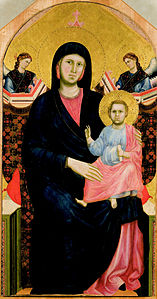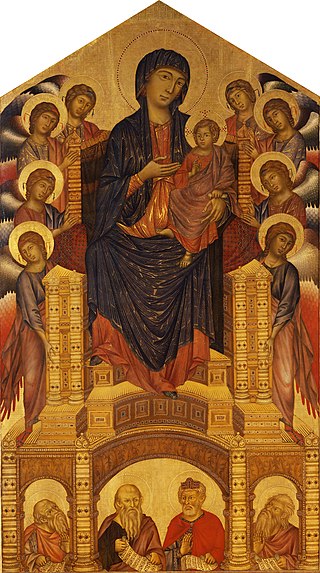
Cimabue, c. 1240 – 1302, was an Italian painter and designer of mosaics from Florence. He was also known as Cenni di Pepo or Cenni di Pepi.
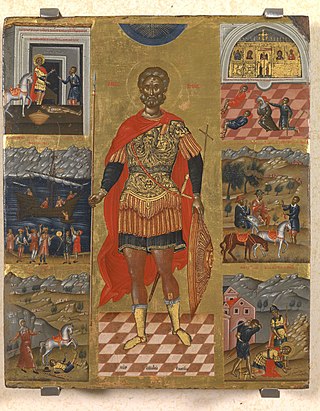
Cretan school describes an important school of icon painting, under the umbrella of post-Byzantine art, which flourished while Crete was under Venetian rule during the late Middle Ages, reaching its climax after the Fall of Constantinople, becoming the central force in Greek painting during the 15th, 16th and 17th centuries. The Cretan artists developed a particular style of painting under the influence of both Eastern and Western artistic traditions and movements; the most famous product of the school, El Greco, was the most successful of the many artists who tried to build a career in Western Europe, and also the one who left the Byzantine style farthest behind him in his later career.

This article about the development of themes in Italian Renaissance painting is an extension to the article Italian Renaissance painting, for which it provides additional pictures with commentary. The works encompassed are from Giotto in the early 14th century to Michelangelo's Last Judgement of the 1530s.

Emmanuel Tzanes, also known as BounialisEmmanuel Tzane-Bounialis, Emmanuel Zane, and Emmanuel Tzane, was a Greek Renaissance painter, author, clergyman, and educator. He spent the latter half of his life in Venice, where he was parish priest of the church of San Giorgio dei Greci and a member of the Flanginian School run by the city's Greek Confraternity. Tzanes painted in the style of the Cretan School, influenced by contemporary trends in Venetian painting. His known extant works, over 130 in number, can be found in public foundations, private collections, churches and monasteries in Greece. The most popular of these is The Holy Towel, finished in 1659. Tzanes was a collaborator with Philotheos Skoufos, and brothers with the painter Konstantinos Tzanes and the poet Marinos Tzanes.

Angelos Akotantos was a Greek painter, educator, and protopsaltis. He painted icons in the maniera greca, at a time when that style was moving away from the traditions of the Byzantine Empire and towards the more refined aesthetic of the Cretan School. Akotantos taught painting to Andreas Pavias, Andreas Ritzos, and Antonios Papadopoulos, and his style influenced later artists such as Georgios Klontzas, Theophanes the Cretan, Michael Damaskinos and El Greco. Angelos's brother Ioannis was also a famous painter. There are 50 extant paintings reliably attributed to Akotantos, 30 of which bear his signature.
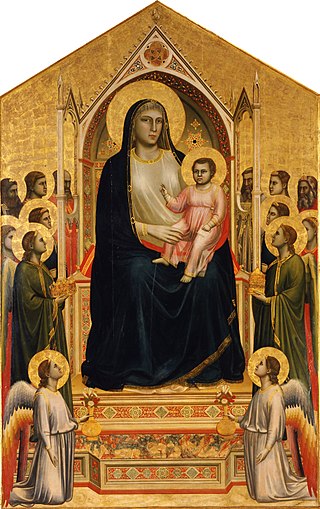
Madonna Enthroned, also known as the Ognissanti Madonna, or just Madonna Ognissanti, is a painting in tempera on wood panel by the Italian late medieval artist Giotto di Bondone, now in the Uffizi Gallery of Florence, Italy.

The Rucellai Madonna is a panel painting representing the Virgin and Child enthroned with Angels by the Sienese painter Duccio di Buoninsegna. The original contract for the work is dated 1285; the painting was probably delivered in 1286. The painting was commissioned by the Laudesi confraternity of Florence to decorate the chapel they maintained in the Dominican church of Santa Maria Novella. It was transferred to the Galleria degli Uffizi in the 19th century. The Rucellai Madonna is the largest 13th-century panel painting extant.
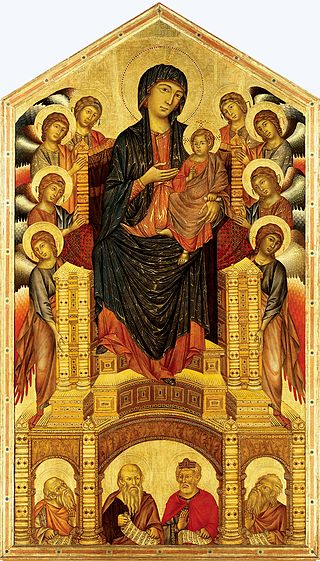
The Santa Trinita Maestà is a panel painting by the Italian medieval artist Cimabue, dating to c. 1288-1292. Originally painted for the church of Santa Trinita, Florence, where it remained until 1471, it is now in the Uffizi Gallery of Florence, Italy. It represents the Madonna enthroned with the Baby Jesus and surrounded by eight angels and, below, four half portraits of prophets.

Andreas Ritzos also known as (Andreas Rico, Ricio or Rizo) was a Greek icon painter from Crete. Ritzos is considered one of the founding fathers of the Cretan School. He was affiliated with Angelos Akotantos. Most of his work stylistically follows the traditional maniera greca. His children, grandchildren, and great-grandchildren were also painters. He was one of the most influential painters of the Cretan School along with Andreas Pavias and Angelos Akotantos. He influenced the works of Georgios Klontzas, Nikolaos Tzafouris, Theophanes the Cretan, Michael Damaskinos and El Greco. According to the Institute for Neohellenic Research, sixty of his paintings have survived.

Italo-Byzantine is a style term in art history, mostly used for medieval paintings produced in Italy under heavy influence from Byzantine art. It initially covers religious paintings copying or imitating the standard Byzantine icon types, but painted by artists without a training in Byzantine techniques. These are versions of Byzantine icons, most of the Madonna and Child, but also of other subjects; essentially they introduced the relatively small portable painting with a frame to Western Europe. Very often they are on a gold ground. It was the dominant style in Italian painting until the end of the 13th century, when Cimabue and Giotto began to take Italian, or at least Florentine, painting into new territory. But the style continued until the 15th century and beyond in some areas and contexts.
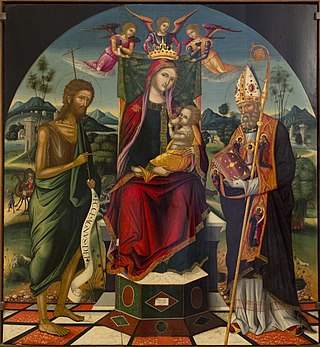
Ioannis Permeniates also known as Giovanni Permeniate, Joannes Permeniates and, Zuan Permeniatis. He was a Greek painter in Venice active during the early 16th century. His most popular painting is The Virgin and Child Enthroned. He was a Greek icon painter who attempted to escape the maniera greca. His icons exhibit qualities of both Venetian and Cretan styles. Exhibiting a more refined maniera greca, he eschews the simplicity of Duccio and Cimabue, and adds more space to his paintings.

Ιoannis Apakas, also known as Johann Apakass was a Greek painter and priest. He was active in the latter part of the 16th century to the early 17th century. He was popular artist during his time.
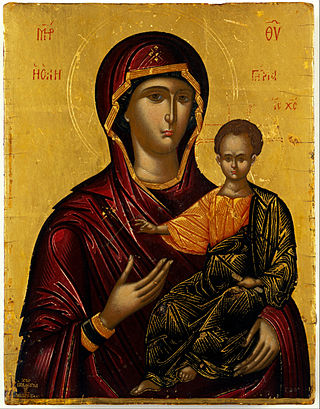
Emmanuel Lampardos, also known as Emmanouil Lampardos and Manolitzis. He was a Cretan Renaissance painter. Emmanuel and his nephew Emmanuel Lampardos have been very difficult to distinguish because they were active painters around the same period. Countless Greek and Italian artists emulated the famous painters. The name Lampardos was very notable in reference to Cretan art. The family was affiliated with famous painters Franghias Kavertzas and Tzortzi Papadopoulo. Lampardos emulated Georgios Klontzas, Michael Damaskinos, Angelos Akotantos, Andreas Pavias, Andreas Ritzos and Nikolaos Tzafouris. His style was the typical maniera greca with a strong Venetian influence. Countless images of the virgin and child have survived. Lampardos influenced Franghias Kavertzas, Emmanuel Tzanes, Philotheos Skoufos Elias Moskos, Leos Moskos, Ioannis Moskos and Emmanuel Tzanfournaris. Over fifty-six icons have been attributed to Lampardos.
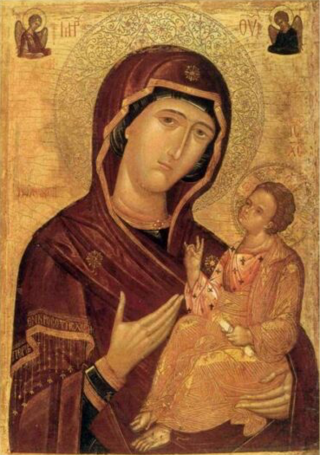
Nikolaos Lampoudis was a 15th Century Greek painter from Sparta. The only work of his of which historians are aware is an icon of the Virgin and Child of a kind known as a hodegetria or eleusa.

Georgios Kalliergis or Kallergis was a Byzantine Greek painter. He is one of the few Greek painters of the Byzantine empire known by name. Other Byzantine painters include: Theodore Apsevdis, Kokkinobaphos Master, and Ioannis Pagomenos. Kalliergis was one of the masters of Thessaloniki. He was part of the Macedonian School of painting. His last name Kallergis was associated with a noble family from the island of Crete. Two other very famous Greek painters Nikolaos Kallergis and Christodoulos Kalergis shared the same last name. Georgios was associated with Mount Athos, Veria, and Thessaloniki. His most notable frescos are in the Church of the Resurrection of Christ in Veria, Greece.
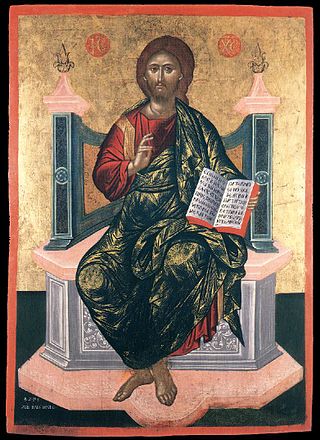
Christ Enthroned is a tempera painting by Elias Moskos, a representative of the Late Cretan School. The artist was also associated with the Heptanese School due to his migration to Zakinthos and the transition of his painting style. Moskos also taught painting. Most of his students became church committee members. Church committees were responsible for commissioning paintings. He was active from 1645 to 1687 on the islands of Crete, Zakynthos, and Kefalonia. Fifty-two of his works survived, over half of them were signed. Two other painters named Moskos were active during the same period Ioannis Moskos and Leos Moskos.

Lady the Lambovitissa is a tempera painting by Emmanuel Tzanes. Tzanes was a Greek painter active from 1625 to 1690. His artistic periods can be broken into three parts. The Cretan Period (1625-1647), The Corfu Period (1647-1655), and the Venetian Period (1655-1690). He was a prominent member of the Late Cretan School. His art was heavily influenced by Greek painter Michael Damaskinos. His brothers Marinos Tzanes and Konstantinos Tzanes were both painters. Tzanes has a massive art collection attributed to him nearing over one hundred thirty works. During the Corfu Period (1647-1655), Konstantinos Tzanes and Emmanuel were heavily active. They painted many works on the island.

The Virgin Glykofilousa with the Akathist Hymn is a tempera painting created by Greek painter Stephano Tzangarola. The work is a symbol of the craftsmanship of the Heptanese School and the evolution of Greek painting from the Byzantine style to the Cretan Renaissance style. Tzangarola was originally from Crete and migrated to Corfu. The Ionian Islands became the artistic center of the Greek world. He was active from 1675 to 1710 during the Greek Baroque period and Rococo. Twenty-two of his works survived. His student was famous Greek painter and Archpriest Andreas Karantinos.
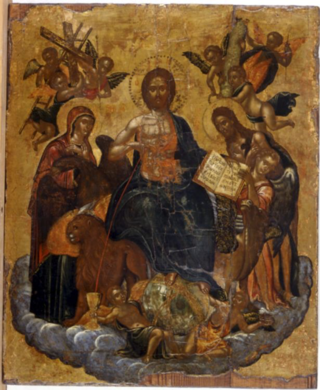
Tribute to the Eucharist was a painting made of egg tempera and gold leaf on a wood panel. The portable icon is attributed to Greek painter Michael Damaskinos. Damaskino's existing catalog features over 100 known works. He was a member of the Cretan school of painting. He was from the island of Crete. His contemporaries were Georgios Klontzas and El Greco. Damaskinos traveled all over Italy for over twenty years. He spent a significant amount of time in Venice. He adopted Italian mannerisms. He applied these new attributes to his paintings. He was friends with sculptor Alessandro Vittoria. He had a collection of drawings obtained from other Italian artists. Namely the Mannerist Parmigianino. He was also exposed to the magnificent works of Italian painter Raphael.

The Virgin and Child Enthroned is a tempera painting created by Spyridon Romas. He was a Greek painter from the island of Corfu and a prominent member of the Heptanese School active from 1745 to 1786 in Corfu, Lecce, Livorno, and London. Twenty-five of his works survived according to research completed by the Hellenic Institute. One of few Greek painters that changed his style completely Romas transitioned from the Heptanese School to the British style of painting. He traveled to London, England around 1770, and remained in the country until his death. Romas painted several portraits but also maintained art. An important iconostasis containing most of his works is preserved in Livorno, Italy at the Museo della Città di Livorno.






